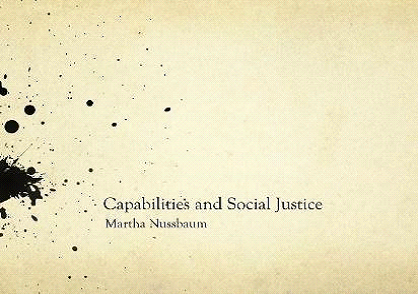Theories of John Rawls, Amartya Sen, and Martha Nussbaum: A Comparison
⦁ Is justice a universal concept or is it something that each individual experiences differently?
⦁ Is it shaped by what an individual believes is possible?
⦁ Is justice seen only as something to be delivered through the courts or does it entail other facets?

John Rawls’ Theory of Justice
John Rawls’s theory of justice as fairness envisions a society of free citizens holding equal basic rights cooperating within an egalitarian economic system. The two principles that emanate from the notion of justice as fairness are:
⦁ Each person has an equal right to a fully adequate scheme of equal basic liberties which is compatible with a similar scheme of liberties for all,
⦁ Social and economic inequalities are to satisfy two conditions. First, they must be attached to offices and positions open to all under conditions of fair equality of opportunity; and second, they must be to the greatest benefit of the least advantaged members of society.
The significance of Rawls’ Theory of Justice lies in understanding how institutions involved in securing justice need to be seen as fair by those covered by them, and that there is scope to examine social and economic inequalities from the perspective of whether these institutions offer equal opportunity, and are of greatest benefit, to the poorest or the least advantaged. Rawls’ conception of justice offers the opportunity to provide voices to the marginalized in debates of justice, through questioning what meaning women would give to the word “fairness”.
Amartya Sen’s Idea of Justice and the Capability Approach

Amartya Sen challenges the idea of the hypothetical ‘original position where all men are equal’. He points out that the earlier conceptions focus on the ‘arrangement-focus of justice’, and instead offers a ‘realization-focused understanding of justice’ where it “concentrates on the actual behavior of people, rather than presuming compliance by all with ideal behavior”.
Sen argues that there is room for multiple reasoning and plurality of impartial reasoning; while building an understanding of justice, he also brings into the discussion the role of wrath and indignation to present a persuasive argument for alternative justice. In short, he makes a strong case for including in the concept of justice not just an originally, ideal world order, rather also how it is realized and ‘seen to be done’.

Sen’s work on the capabilities approach to development focuses on human lives and not just the resources people have, through ownership or use of objects of convenience and achievement of goals; instead, Sen argues that the means of achieving that goal and the freedom to choose between different opportunities is equally important.

Martha Nussbaum’s Conception of Capabilities Approach
Nussbaum comes from a philosophy background, and uses the capabilities approach to offer 10 universal capabilities which would allow for comparisons across cultures and nations. Nussbaum’s capabilities approach is centered around the notion of individual human dignity. Her list of central capabilities provides the basis for determining a decent social minimum in a variety of areas, and she concedes that it does not lead to a complete theory of justice. Her list includes the following:

⦁ Life (being able to live)
⦁ Bodily health (being able to have good health)
⦁ Bodily integrity (having one’s bodily boundaries treated as sovereign)
⦁ Senses, imagination, thought (being able to use the senses to imagine/think/reason)
⦁ Emotions (being able to have attachments outside ourselves)
⦁ Practical reason (being able to engage in critical reflection)
⦁ Affiliation (being able to engage in various forms of social interaction and having the social basis of self-respect and non-humiliation)
Other species (being able to live with concern for and in relations to others including animals and plants)
⦁ Play (being able to enjoy recreational activities)
⦁ Control over one’s environment (being able to participate effectively in political choices and having property, employment, and other opportunity rights)
Conclusion: The three authors, Rawls, Sen, and Nussbaum forms a continuum between the understanding of justice: Rawls established the need to see justice as fairness, Sen focused on the realization of justice, and Nussbaum and Sen’s work on capabilities can be seen as the ability to realize justice and to have a universal framework to assess human development. Thus, one can say that justice and human development are integrally linked, and that for people to realize justice is a key ingredient of human development.
| John Rawls | Amartya Sen | Martha Nussbaum |
| Citizens are free and equal, and that society should be fair. | Freedom to achieve well-being is a matter of what people can do and be. | Human life, in order to reach its highest potential, must include several “capabilities” – that is, of actual possibilities that one can realize in one’s life. |
| A Theory of Justice holds that every individual has an equal right to basic liberties, and that they should have the right to opportunities and an equal chance as other individuals of similar ability. Based on the social contract theory, Rawls argued that equal distribution of resources should be the desirable state of nature instead of following utilitarian philosophies | Capability Approach is a moral framework, which involves two core normative claims. First, the assumption that freedom to achieve well-being is of primary moral importance. And second, that freedom to achieve well-being must be understood in terms of people with capabilities. In other words, their real opportunities to do and be what they value. | Martha Nussbaum’s capabilities include the ability to live a life that is “worth living,” the ability to use one’s imagination, sufficient education to enable a “truly human” understanding of the world and one’s position in it, having dignity and a sense of equal worth, as well as the ability to participate in the political life of one’s society. |
Disclaimer: This is a summary handout I had prepared during an internship program. The content belongs to the author/s of the original article/s.
